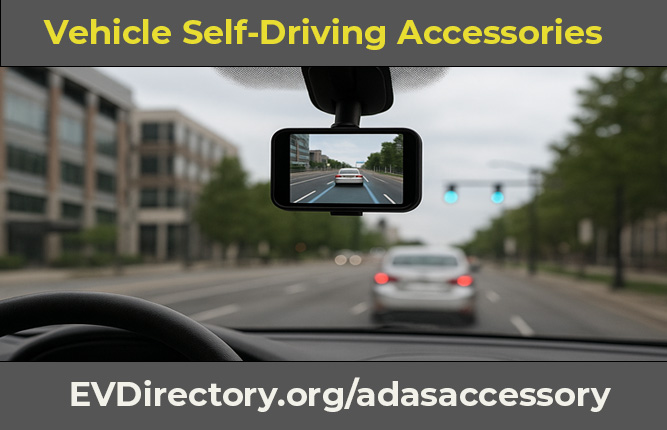Vehicle self-driving accessories are aftermarket devices that use sensors, cameras, and AI to monitor surroundings, connect to vehicle systems, and assist or automate driving tasks like steering, braking, and lane-keeping. Self-driving aftermarket accessories address the challenge of upgrading older or non-autonomous vehicles with advanced driver-assistance and safety features. They solve key issues such as driver fatigue, collision risks, and the lack of intelligent navigation found in traditional vehicles. These accessories feature adaptive learning to improve performance over time, high-performance AI with multi-sensor fusion for accurate perception, and customizable driving assistance like lane centering and adaptive cruise control. Advanced camera capabilities, object recognition, and environment performance ensure reliability in all conditions, while fail-safe systems and data security enhance safety. With OTA updates, fleet integration, and broad vehicle compatibility, these systems are future-proof and user-friendly.
Vehicle Self-Driving Accessory Companies

Vehicle Self-Driving Accessory Company List
Bosch Mobility – The automotive division of Bosch offers aftermarket-capable lane keeping and centering assist systems using video based camera tech.
Comma.ai – Provides the comm 3X device and openpilot software that bring Tesla’s like ADAS features to hundreds of vehicle models via plug in hardware.
Innoviz Technologies – Develops automotive-grade solid-state lidar (InnovizOne/InnovizTwo) and perception software for integration into ADAS and autonomous systems.
Luminar Technologies – Specializes in high-performance lidar (Iris) and full-stack safety systems (Sentinel) that can augment ADAS and support highway autonomy.
Mobileye – A pioneer in vision‑based ADAS, using proprietary camera sensors (EyeQ chips) to deliver lane keeping, collision warning, and aftermarket safety kits.
Vehicle Self-Driving Accessory Key Features and Capabilities
Adaptive Learning
Adaptive learning allows the AI system to improve its driving performance over time by analyzing user behavior, traffic patterns, and road conditions. This is important because it enables the device to become safer and more efficient as it gains real-world driving experience.
AI and Algorithm Performance
High-performance AI and advanced algorithms ensure accurate, real-time processing for lane detection, obstacle avoidance, and driver assistance. This is crucial because delayed or inaccurate decisions can compromise safety and reduce trust in the system.
Camera Capabilities
The quality of onboard cameras, including resolution, field of view, and night-vision capabilities, determines how effectively the system can detect objects and read road signs. This is important because precise visual data is the foundation of reliable autonomous decision-making.
Data Privacy and Security
Strong encryption and secure data protocols protect sensitive information collected by sensors and cameras from unauthorized access. This is important because connected devices are vulnerable to cyber threats, and data breaches can compromise both user safety and privacy.
Driver Monitoring
Driver monitoring features, such as eye-tracking cameras and alerts for drowsiness or distraction, help ensure that the driver remains attentive when needed. This is essential because even semi-autonomous systems require a responsible human backup to avoid accidents.
Driver Profiles
Customizable settings for driving style, including following distance, lane-change behavior, and acceleration patterns, allow for a tailored driving experience. This is important because it gives drivers flexibility to adjust the system to match their comfort and safety preferences.
Driving Assistance Customization
Features such as adjustable lane centering, adaptive cruise control, and speed management can be fine-tuned based on user preferences. This is valuable because it helps drivers maintain control while still benefiting from automated assistance.
Ease of Installation
An accessory that requires minimal setup or vehicle modification is easier to install and reduces the risk of improper configuration. This is important because complex installations can deter customers or lead to safety issues if not done correctly.
Environment Performance
Reliable performance in adverse conditions such as rain, fog, glare, and low light ensures consistent operation in real-world driving. This is essential because weather and lighting conditions vary widely, and a failure to adapt can result in safety hazards.
Expandability
Devices that support the addition of new features, modules, or hardware upgrades without replacing the entire system provide longer-term value. This is important because technology evolves rapidly, and future-proofing reduces costs and extends device usability.
Fail-Safe Systems
Redundant sensors and emergency override features ensure that the system can safely handle malfunctions or failures. This is crucial because even small technical errors can have serious consequences if the system is not designed with safety backups.
Fleet Integration Support
Integration with fleet management systems allows data tracking, driver analytics, and performance reporting across multiple vehicles. This is important because it provides fleet operators with actionable insights to improve efficiency and safety.
Multi-Sensor Fusion
Combining radar, LiDAR, ultrasonic sensors, and cameras improves the system’s ability to perceive its surroundings accurately. This is valuable because using multiple sensing technologies creates a more reliable and robust understanding of complex environments.
Navigation System Integration
Built-in compatibility with GPS and real-time mapping allows optimized route planning and enhances autonomous navigation. This is important because accurate mapping is critical for avoiding traffic, hazards, or unexpected obstacles.
Object Recognition
Advanced object recognition identifies pedestrians, cyclists, vehicles, animals, and road signage with high accuracy. This is crucial because timely detection of potential hazards prevents collisions and improves overall safety.
Safety and Compliance
Meeting established automotive safety and regulatory standards (e.g., ISO 26262, UNECE) ensures the product is approved for use and meets quality benchmarks. This is important because non-compliant systems can pose legal risks and may fail to meet safety requirements.
Update Support
Over-the-air (OTA) software updates ensure the device stays current with new features, bug fixes, and performance improvements. This is vital because regular updates extend the life of the product and enhance safety by fixing vulnerabilities.
User Interface and Alerts
A clear, user-friendly interface with visual and audio alerts helps drivers quickly understand system feedback. This is important because confusing or unclear notifications can lead to driver errors or missed warnings.
V2X Communication
Vehicle-to-everything (V2X) technology enables communication with other vehicles, infrastructure, and traffic systems to improve awareness. This is valuable because it allows the system to anticipate hazards beyond the range of its sensors, enhancing safety and traffic flow.
Vehicle Compatibility
Compatibility with OBD-II, CAN bus, and other communication protocols ensures the accessory can connect with a wide range of vehicles. This is essential because poor compatibility limits installation options and functionality.
Vehicle Control Integration
Seamless integration with steering, throttle, and braking systems allows the accessory to safely manage vehicle control when required. This is vital because it ensures the device can effectively assist or take over driving tasks without interfering with the vehicle’s natural operations.
Vehicle Self-Driving Accessory Glossary
Advanced Driver Assistance Systems (ADAS) – A suite of electronic technologies, such as adaptive cruise control and lane-keeping assist, designed to enhance vehicle safety and automate certain driving tasks.
Artificial Intelligence (AI) – The technology enabling self-driving systems to process data from sensors and cameras, make decisions, and improve performance through machine learning.
Autonomous Emergency Braking (AEB) – A safety system that automatically applies brakes when a potential collision is detected, reducing or preventing accidents.
Controller Area Network (CAN) – A robust vehicle bus system that allows microcontrollers and devices to communicate without a host computer, commonly used for accessing vehicle data and controls.
Electronic Control Unit (ECU) – A microcontroller responsible for managing specific vehicle functions, such as engine control or braking systems, often accessed by self-driving devices.
Electronic Stability Control (ESC) – A system that improves vehicle stability by detecting and reducing loss of traction or skidding.
Functional Safety (ISO 26262) – An international automotive standard ensuring that electronic and electrical systems operate safely under defined conditions.
Global Navigation Satellite System (GNSS) – A general term for satellite positioning systems, including GPS, GLONASS, and Galileo, used for accurate vehicle location.
Global Positioning System (GPS) – A satellite-based navigation system used for precise vehicle location, route planning, and autonomous navigation features.
Light Detection and Ranging (LiDAR) – A sensor technology that uses laser pulses to measure distances and create 3D maps of the vehicle’s surroundings for object detection and navigation.
Machine Learning (ML) – A subset of AI where algorithms improve their performance by learning from data, critical for self-driving systems to adapt to real-world conditions.
Object Detection (OD) – The capability of sensors and cameras to recognize and classify surrounding objects such as pedestrians, vehicles, and road signs.
On-Board Diagnostics (OBD-II) – A standardized vehicle interface that provides access to diagnostic information, vehicle performance data, and communication with aftermarket devices.
Over-The-Air (OTA) – A method of remotely updating a device’s software or firmware, ensuring the accessory stays current with new features and bug fixes.
Radar (Radio Detection and Ranging) – A sensor technology that uses radio waves to detect objects’ distance, speed, and movement, essential for collision avoidance.
Sensor Fusion (SF) – The process of combining data from multiple sensors (e.g., cameras, radar, LiDAR) to create a more accurate understanding of the driving environment.
Ultrasonic Sensors (USS) – Sensors that use ultrasonic waves to detect nearby objects, commonly used for parking assistance and close-range detection.
Vehicle-to-Everything (V2X) – Communication technology enabling the vehicle to exchange data with infrastructure, other vehicles, and devices for enhanced safety and traffic management.
Vehicle Control Unit (VCU) – A central electronic system that manages key vehicle operations like braking, steering, and acceleration, which self-driving accessories may interface with.

